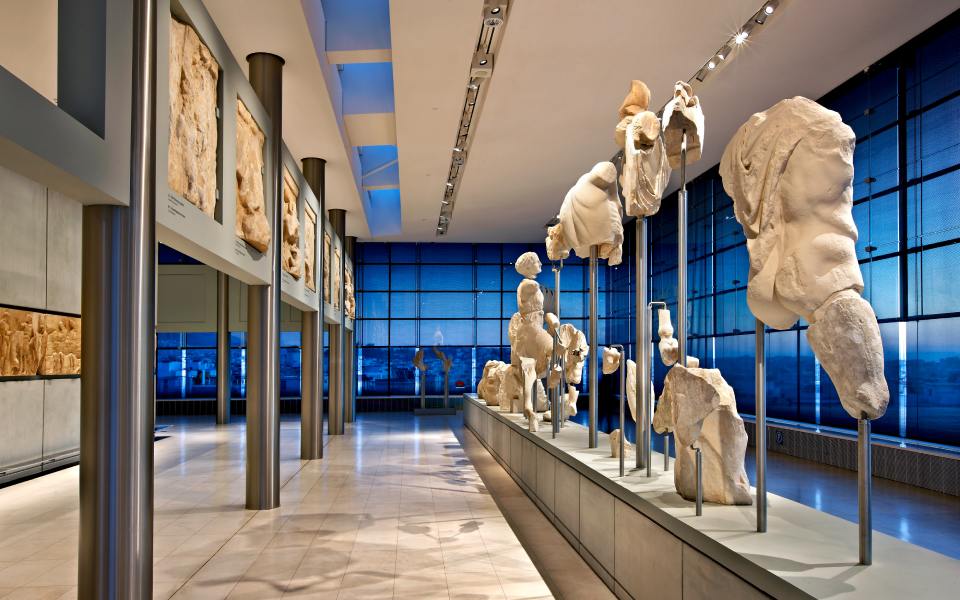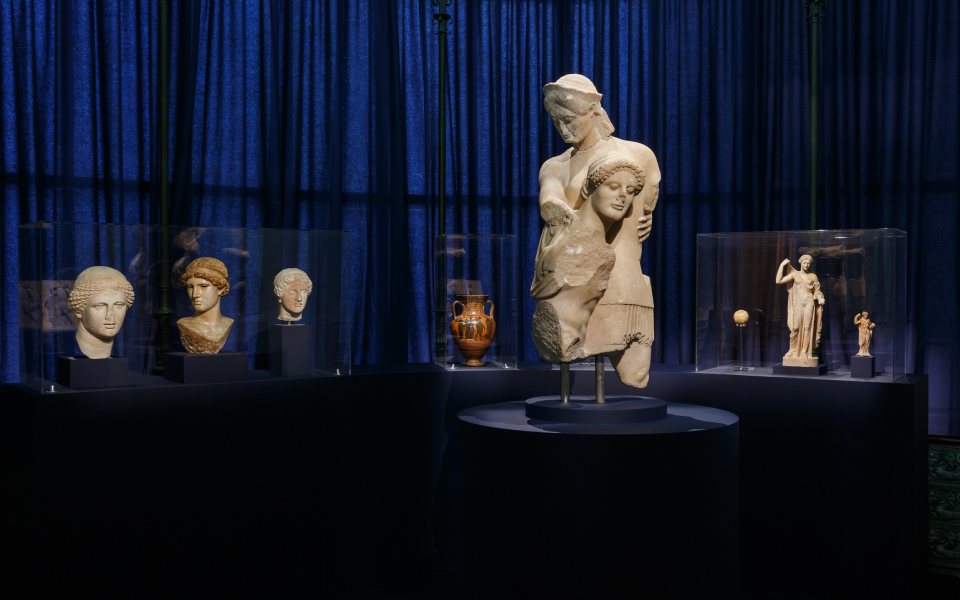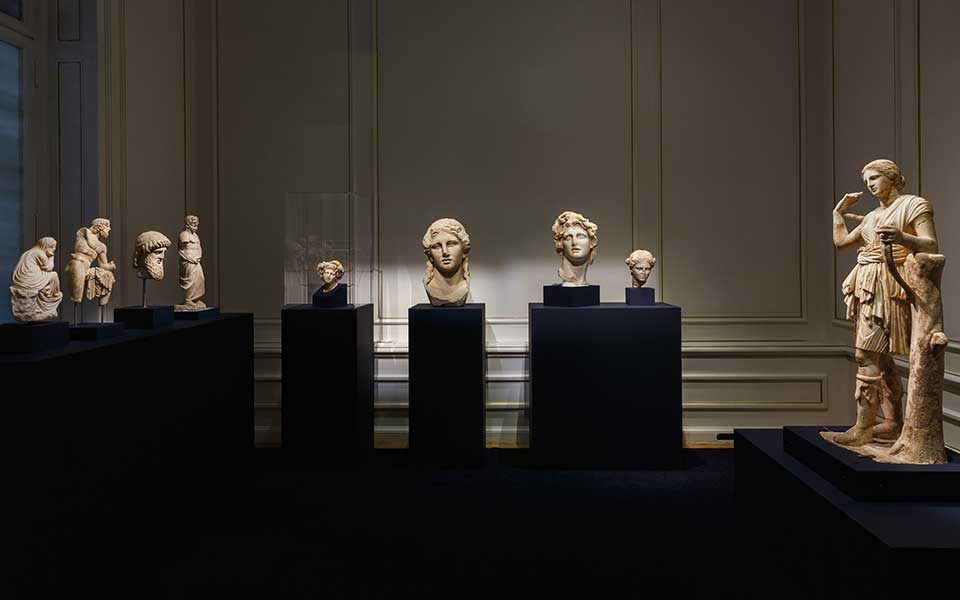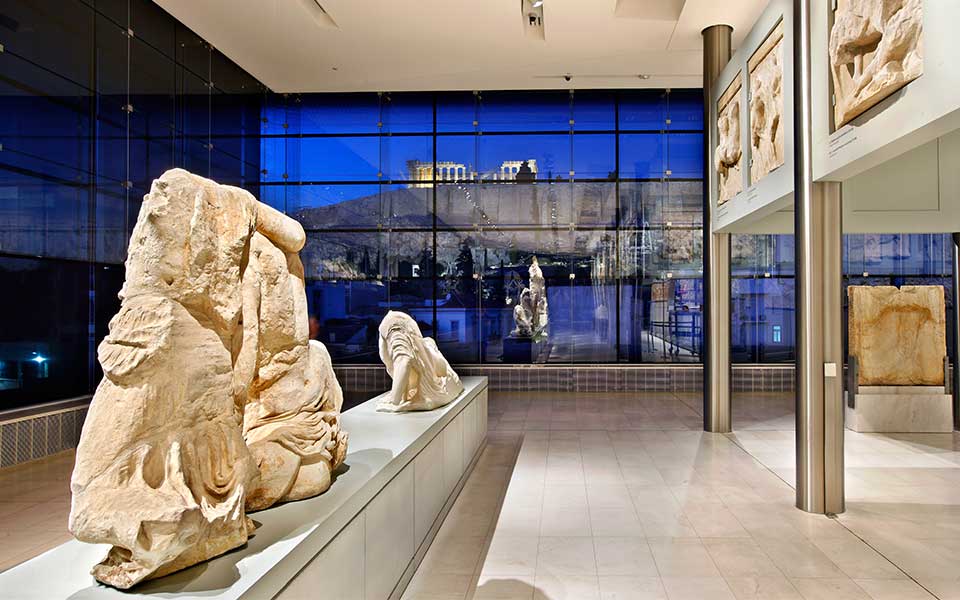“The ideal of beauty is a notion more recent civilizations have in our mind,” notes Professor Nikos Stampolidis, before taking us on a journey into the exhibition “Kallos: The Ultimate Beauty.” With this exhibition he closes a successful 25-year tenure as Director of the Museum of Cycladic Art, and will begin a new journey as elected Director of the Acropolis Museum, the first general manager in the museum’s history.
In the end, what does beauty mean, the idea of flawless? “It is something beauteous, something with good shape. It is not only what our retina perceives, but also our inner eye. As such, the notion of exterior beauty and inner beauty may sometimes correspond, and other times not. That is why the ancient Greeks realized that what is optically beautiful must also be good inside, as virtuous. In other words, kalos kagathos (beautiful and virtuous, the ideal of gentlemanly personal conduct). I believe that the ideas, notions and meanings created in our mind are imprisoned, if not stillborn, if you cannot express them with words.”
In this exhibition (from September 29), curated by professor Nikos Stampolidis and Dr. Ioannis D. Fappas, it is clear that the notion of “kallos” in its ultimate expression does not only refer to “beauty.” The ideal that developed in ancient Greek thought and expressed through the epic poems (8th century BC) and the lyrical poems (7th–6th century BC), was gradually crystallized in the texts of philosophers in the 5th–4th centuries BC. They referred to this ideal as a combination of physical appearance and virtues of the soul. Here, visitors can admire the facets of kallos in ancient Greek daily life and philosophical thought through the 322 artifacts on display, from museums and collections from Greece, Italy and the Vatican.

© Shutterstock
“If you begin with Homer and move on to lyric poetry, you would think the notion of kallos is external. But if you read the phrases in context, you realize that Penelope, for example, is not just a sophisticated and beautiful queen; she also acquires characteristics of virtue for her loyalty and patience. And take note: these virtues are reflected in the face,” Professor Stampolidis says to Kathimerini newsletter, highlighting that we need to learn to think differently about how people viewed things in antiquity; to try to use their criteria, not our own.
“It is wrong to think that the Fair Helen, for instance, was not good – ethically. Perhaps we are viewing it through Victorian standards, or our more conservative lenses, while the reason Helen abandoned her husband is beyond reason – it was love. In this case, there is nothing you can do.”
Spread across both museum buildings, the Neophytou Douka wing and the Stathatos Mansion, the exhibition sheds light on all stages of the beautifying process; the celebration of the natural beauty of youth, both men and women in ancient Greece; the “kallos” of mortals represented through figures known for their beauty, such as the Fair Helen, Adonis, as well as other forms of beauty – the athletic, the heroic, and even the daemonic (Medusa, Scylla, the Sphinx). The unit “Timely Beauty, untimely death” is also included, featuring the young who encountered unjust and untimely demise in their prime, as well as “Abductions of beauty and erotic encounters.”
This is Stampolidis’ favourite unit in the exhibition. “Because a human-centric civilization, such as the ancient Greeks, is one that creates divinities in the likeness of humans, and not vice versa, such as in Judaism. With all their power and abilities, the gods themselves fall into the snare of beauty, wanting to abduct and lie with it, because there is no eros without erotic encounters. You want to possess it.”

© Acropolis Museum. Photo Nikos Daniilidis
The abduction of beauty is one of the most sensual units in the exhibition. Scenes of congress, desire and passion that are directly or indirectly connected with abductions. In the exhibition catalogue (which is worth acquiring), Stampolidis notes that Zeus was the protagonist in the abduction of young women. He abducts Europa in the form of a bull, as depicted in the Cycladic Museum’s red-figure krater, 400-375 BC. On another red-figure vase dating from approximately 430 BC he chases the nymph Aegina, amid her startled sisters. “The reference of the pursued, inscribed near the figure as KALE (meaning good/beautiful) is characteristic, while the god is also referred to as KALOS.”
Love-struck Poseidon chases Amphitrite on a red-figure compass, dated 460 BC from the island of Aegina. Winged Boreas is depicted abducting the Athenian princess Orithyia as she runs, frightened, towards an altar on an urn from Boeotia, dating from 500-490 BC. It was for her that Boreas blew strong winds that destroyed the Persian fleet, throwing it onto Mount Athos and Artemision as it sailed for Athens.
But it is Avgi (Dawn) who competes with Zeus in the abduction of beautiful, well-formed young men. On a red-figure vase from Attica dating from 460-450 BC she is depicted chasing an unknown youth. “According to the myth, her insatiable erotic desire for young men is attributed to a curse by Aphrodite, because she dared to sleep with Ares.” Abductions of boys also took place on Zeus’ behalf, for instance the abduction of Ganymede by Io.

© Patis Tavitian/Museum of Cycladic Art
Zeus as an Eagle
The bronze mirror from Ilia included in the exhibition is particularly impressive as Zeus, known for his transformations, is depicted as an eagle. “An impressive artwork, with the body of a young boy portrayed on the body of Zeus, the eagle, as he soars in the sky.”
The passionate meeting of Zeus, in the form of a swan, and Lydia is portrayed on a small marble relief from the 1st-2nd century AD. Zeus is “depicted as prominent and violent in comparison with the naked Lydia on the left, who bends her knees in modesty to welcome the god, in the presence of Eros on the right. Abduction, seduction and congress at the same time,” describes Stampolidis, before continuing to the erotic sculpture from the Archaic Temple of Apollo Dafnoforos (Laurel-Bearer) in Eretria.
Whoever created this at the end of the 6th century BC poured their soul into it; depicting King Theseus of Athens having abducted Antiope, Queen of the Amazons, in order to lead her from the Black Sea to, according to Pindar, the haloed, violet city of Athens. “The slight tilting of the head to the front, in combination with her torso that appears to still be resisting, and her right hand in contrast leaning on the back and shoulders of her abductor, reveal psychological upset, resistance and attraction, all at once.” Bodies glued together, and the small details, such as the face of Theseus expressing pleasure, desire, confidence and protection.

© Patis Tavitian/Museum of Cycladic Art
What feelings accompany the end of Stampolidis’ 25-year cycle at the Museum of Cycladic Art? “I leave the MCA with the “Kallos” exhibition, in other words beauty, to ascend to Greek aesthetic quality and the Acropolis Museum. It is all about going upwards, not sliding down. I always remember the words of my mother, when she asked me at the age of 16 what I wanted to do, and I answered: “I want to do what I will do.” She also had the final say: “You should be what you want to be. On one condition: if you are going to be a priest, be the patriarch.”
With regards to his new position, “I do not like to say what I will do, until I do it.”
Between the Acropolis Museum, excavations in the ancient city and necropolis of Eleutherna, the Museum of Eleutherna – how does he do it? “My love for archaeology,” he laughs.
“From my new position I can also do more for Eleutherna. Thank God, I have students that are already university professors, as well as other younger ones. I have managed to teach them so that, with few meetings and minimal guidance, they are able to implement the continuation of the program on site.”
Regarding the excavations at Eleutherna, the focus is now on the east side of the hill. “I am now excavating early Christian ruins. As you see, I do not get stuck in one time period. Archaeology is just one; a single indivisible discipline.
This year’s research is complete – he shows me his calloused palms – while he lists the findings: mosaics, architectural fragments, parapets, sculpted pulpits. “I am waiting for the architects and engineers so we can prepare the study of the early Christian basilica, which still has many Roman architectural features intact. It is essentially the first monument in recent years to be restored with its original roof.”
Before we say our goodbyes, he makes reference to what genuinely touched him in this final exhibition. “In the midst of the pandemic, my colleagues opened 70% of the country’s museums and storerooms. I saw the love and respect of my colleagues, here and abroad. It is no small matter.”
The exhibition will be on until 16-1-2022 and is supported by L’Oréal.
This article was previously published in Greek at kathimerini.gr.












